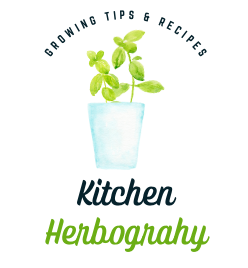As an Amazon Associate I earn from qualifying purchases. This website also participates in other affiliate programs and may earn commissions if you shop through the links used on this website.
(This article was originally published on December 3, 2021 and was last updated on September 4, 2022)
If you’re ready to get started but don’t know how to grow basil indoors, this guide will outline all you need to begin growing basil in your home!
Now that winter is on its way where I live, I start to yearn for the halcyon days of summer, filled with sun-kissed, garden-fresh basil from my patio.
If you also miss the super fresh sweetness of homegrown basil, you might find yourself wondering, can you grow basil indoors as a perennial plant?
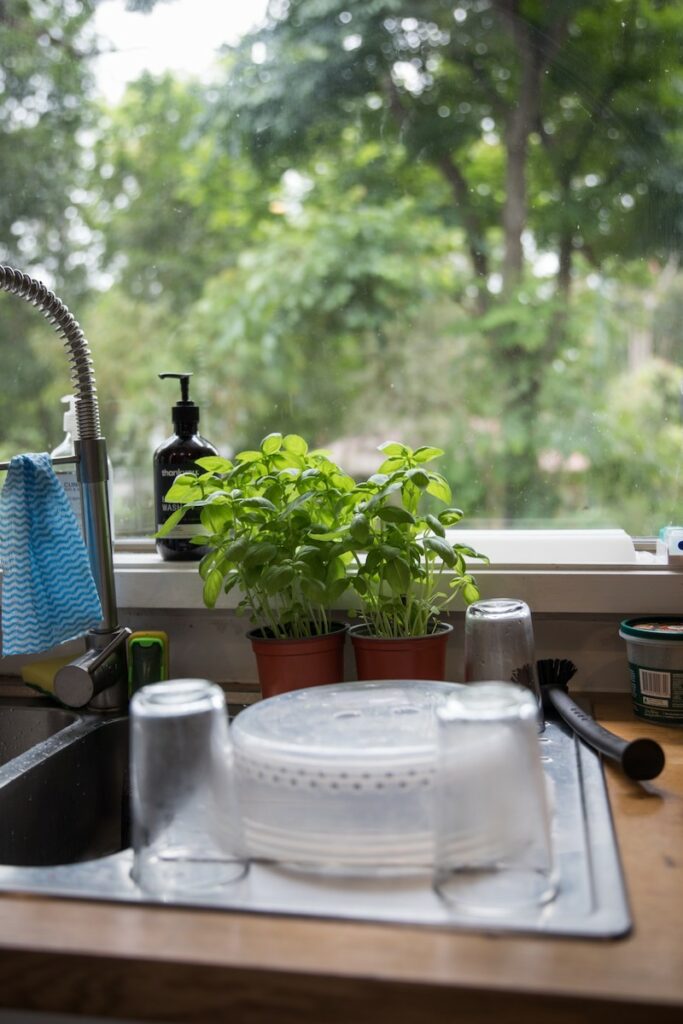
To which I have great news: the answer is a resounding yes!
Even better, it’s incredibly simple to do.
Any home with a warm window that gets plenty of natural sunlight is an easy spot to begin growing basil indoors. In fact, you can even grow some friends for your basil plant, since mint, cilantro, and a whole host of other fresh herbs can be grown right alongside the basil.
Just because overnight frosts have arrived, doesn’t mean you need to give up fresh pesto or sprinkling sweet basil on your homemade pizzas.
Fresh basil is a wonderfully versatile herb that you can grow year round indoors.
If you’re ready to start growing and harvesting basil indoors, this guide will outline all you need to begin growing basil indoors.
From planting seeds to watering and caring for mature plants, you’ll have plenty of fresh basil to add to your recipes in only a few weeks.
So what are you waiting for!?
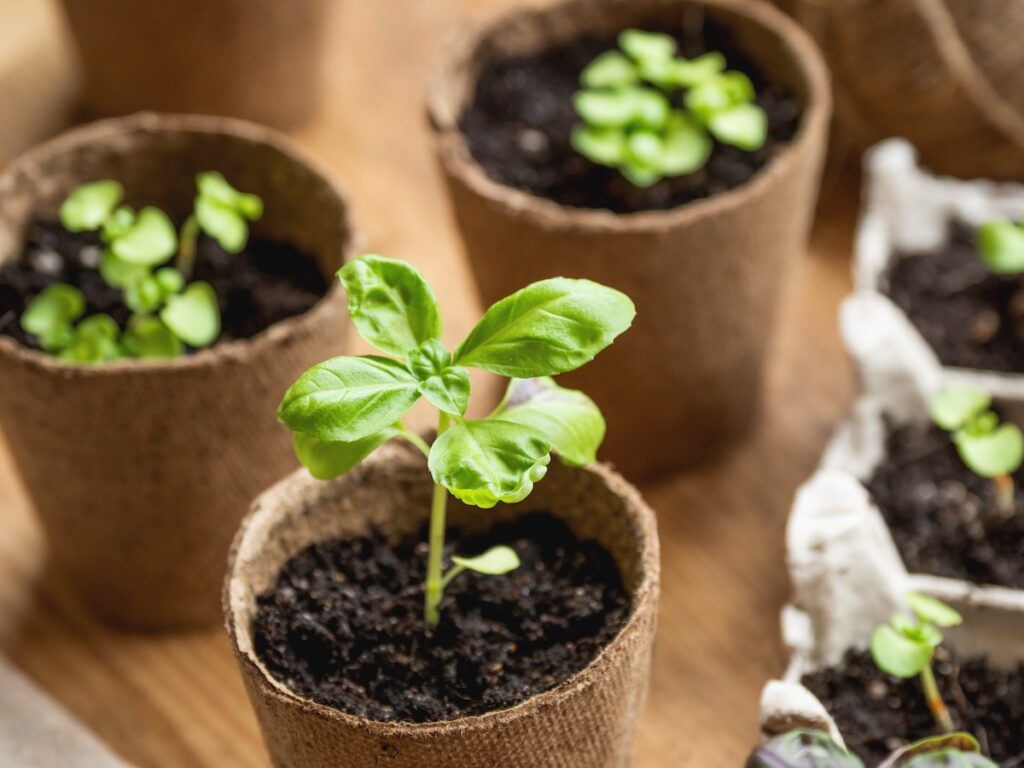
What is the Best Environment to Grow Basil Indoors?
Basil thrives in warm climates, and is a natural summer crop that grows well with warm soil and plenty of sunshine.
When cold temperatures and frost hits your outdoor spaces, however, basil can’t withstand it for very long.
Growing basil indoors is a great way to protect your delicious crop from terrible weather any time of year, or can be a great option to ensure you enjoy the fresh herb through the colder times of year, after the first frost and before the soil warms up again for summer.
Ideally, you’ll have a south-facing window somewhere in your home, which makes a great spot for growing indoors. However, even if you don’t, you can still grow basil indoors year round with the right equipment.
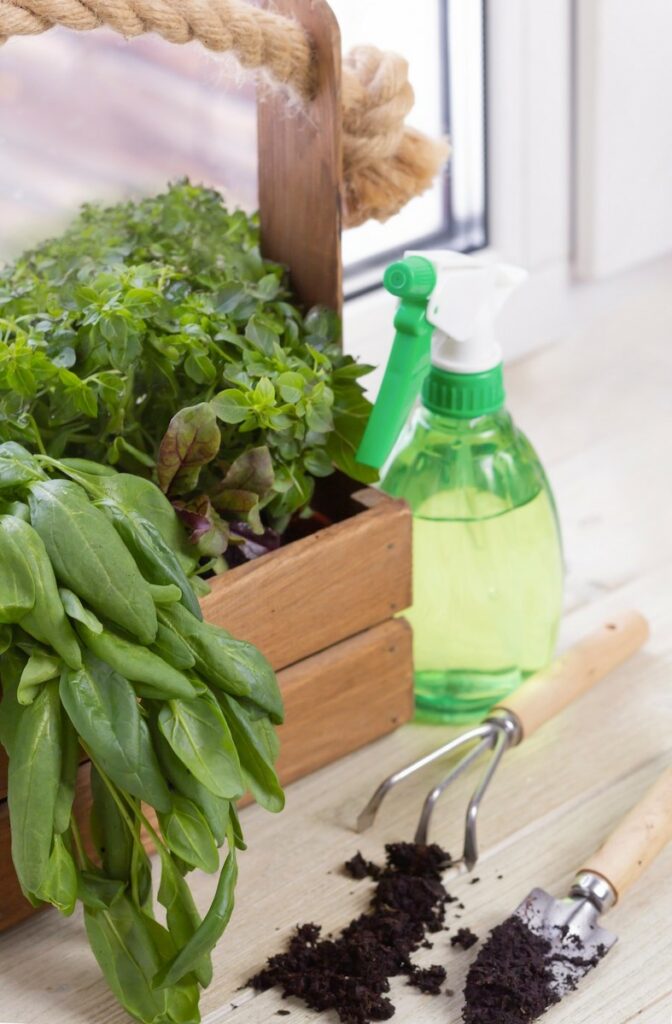
Growing Basil Indoors: A How To Guide
From getting started with seeds and growing gorgeous basil microgreens, and then growing all the way to mature basil plants, below you’ll find a full guide explaining how to grow this delicious and fragrant herb in your own home.
Materials
To grow your own basil herbs indoors, you’ll need a few essential pieces of equipment.
- Basil seeds: Genovese basil seeds are a good option for beginners, and have that classic sweet basil flavor. However, one of the benefits of growing your own basil is you can use any of the many basil varieties you want, and there are a ton of choices out there! Whatever you do, get your seeds from a reputable seller that guarantees they are free from common diseases, or harvest your own seeds from healthy plants that were free of disease during the season. Nothing worse than growing what seems like a healthy plant from scratch to find it falls victim to black spots, holes in the leaves due to fungus, brown patches or white spots as they mature.
- Growing containers: Basil can thrive in a variety of containers, so long as it has good drainage. Choose whatever you have or fits with the style of your home, such as small pots or upcycled jars with drainage holes punched in. You can also buy a specific growing tray. What you grow in will affect how much of a yield you get, so consider how many basil plants you want based on how often you use it in your cooking.
- A growing dome: This is helpful in the early days to keep moisture and humidity in. You can also create a hack by using plastic wrap instead if you’d prefer not to buy a specific piece of equipment.
- A tray to protect your windowsill: When growing indoors, you’ll want to be sure any run-off water that runs out of the drainage holes doesn’t leak all over your home. I like to transfer my basil to the kitchen for watering. I water near the sink and let it drain, and then transfer back to the windowsill and store on a tray.
- Nutrient rich soil: Plain ol’ garden soil won’t cut it when growing from seed, and really isn’t the best choice even when growing mature plants indoors due to possible contamination from bacteria and fungus in your garden. To get the healthiest plants with the best yield, you need a store-bought soil that’s packed with the right combination of nutrients and allows for good drainage. A mix that contains coconut coir or peat moss is good for this, and if you’re starting from seed, get a seed starter mix that includes fertilizer. If basil lacks nutrients, it can turn yellow fairly quickly.
- Organic fertilizer: A well nourished plant is a healthy plant, and will give you the best, most fragrant basil flavor. Make sure whatever you use is suitable for growing edible herbs and produce, and don’t over-fertilize.
- Spray bottle : Especially if growing from seed, a spray bottle is a good way to water plants grown indoors. It allows you to give them water in the beginning, without getting them too soggy.
- Sharp kitchen scissors: For when it comes time to prune your basil and harvest.
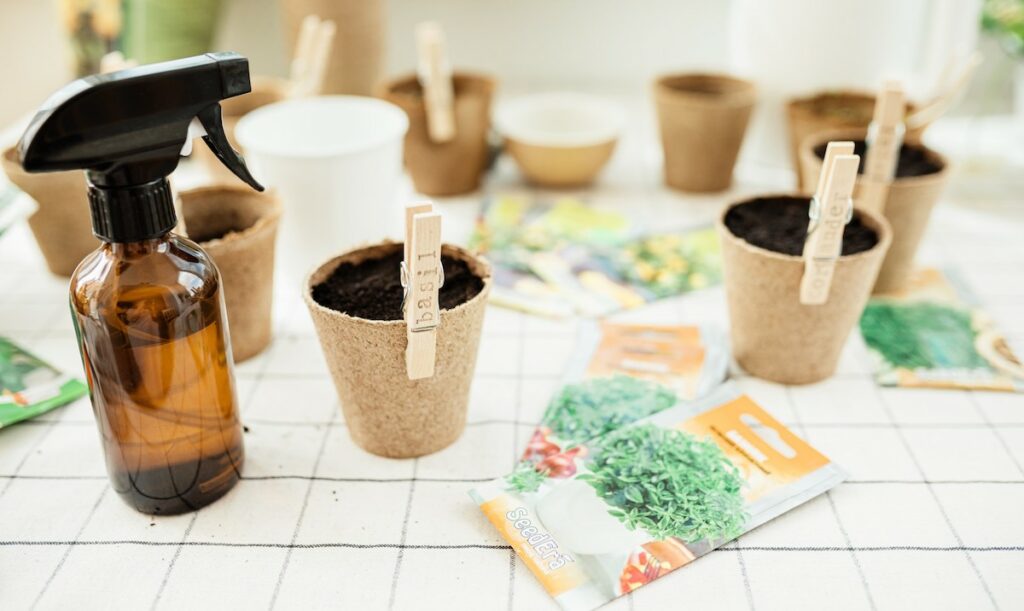
Optional Extras:
- Seedling heating mat: A heated mat will encourage your basil seedlings to sprout faster, and is a good option if you don’t have a warm spot in your house to grow. If you’re growing near a drafty window, this should boost your chances of healthy growth and indoor gardening success.
- Grow lights: Depending on the hours of sunlight your basil will get based on the indoor growing location you choose, grow lights may not be necessary. If you have a super sunny windowsill with many hours of light throughout the year, you can probably skip this. That said, these add-ons are a great hack for healthy plants, and basil requires quite a bit of light. They’re probably worth considering if you plan to grow an aromatic herb garden indoors year-round, and year over year, and are constantly working with young seedlings.
Growing Basil from Seed Indoors
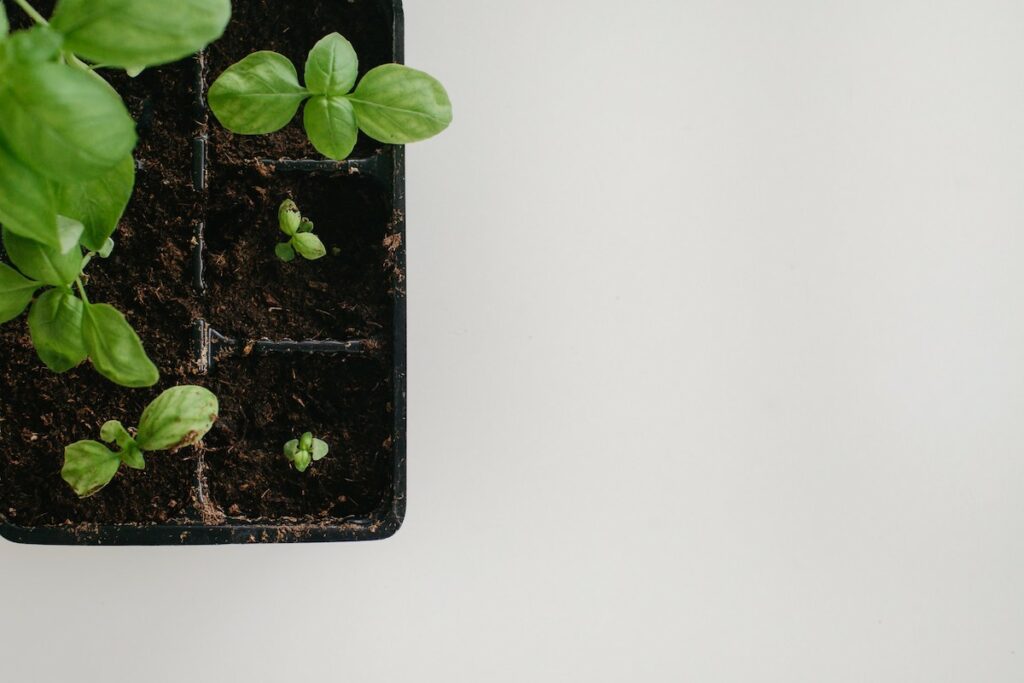
To grow basil from seed indoors, follow these simple instructions:
- I like to prepare soil before using it, by mixing it up and making sure it’s moist but not wet. That said, this is an optional first step – if you’d prefer not to do so, you can simply water the soil once your seeds are placed. To prepare your soil, this mix it in a large bowl with some water until it is damp enough to clump together in your hand but not too wet. You can use a spoon to mix this, but your hands are the best for testing the consistency. It’s a little bit of a trial and error process, but you can always add more water if your mix is too dry and more dry soil if it’s a bit too muddy. Again, make sure you use sterilized soil from a garden center or Amazon, and use one that is suitable for growing from seed.
- Fill your growing containers with the damp soil to about 1/2 to 1 inch below the top.
- Place basil seeds in your growing container. Plant a few seeds extra incase some of them don’t sprout into basil plants – I like to place 2 to 3 per container or growing cell. Gently push them down into the soil until they’re sitting about 1/4″ to 1/2″ deep, and then cover the seeds with a loose thin layer of soil.
- Make sure your seeds have a great environment to sprout in!
- Cover the seeds with a growing dome to keep the moisture in. If the dome is kept in place, you should see basil seedlings begin to form in a few days. You don’t need to add any additional water while the dome is covering the plants.
- Keep your seeds in a warm location with many hours of light. Check them every day.
- Once the sprouts have formed you can remove the dome. Continue to give them direct sunlight and regular care so that they grow into bushy healthy basil plants.
(A heated seed mat can speed up the time it takes for the sprouts to arrive. You can also use a grow light, which can be especially helpful if the leaves are a little yellow.)
How To Care For Basil Grown Indoors
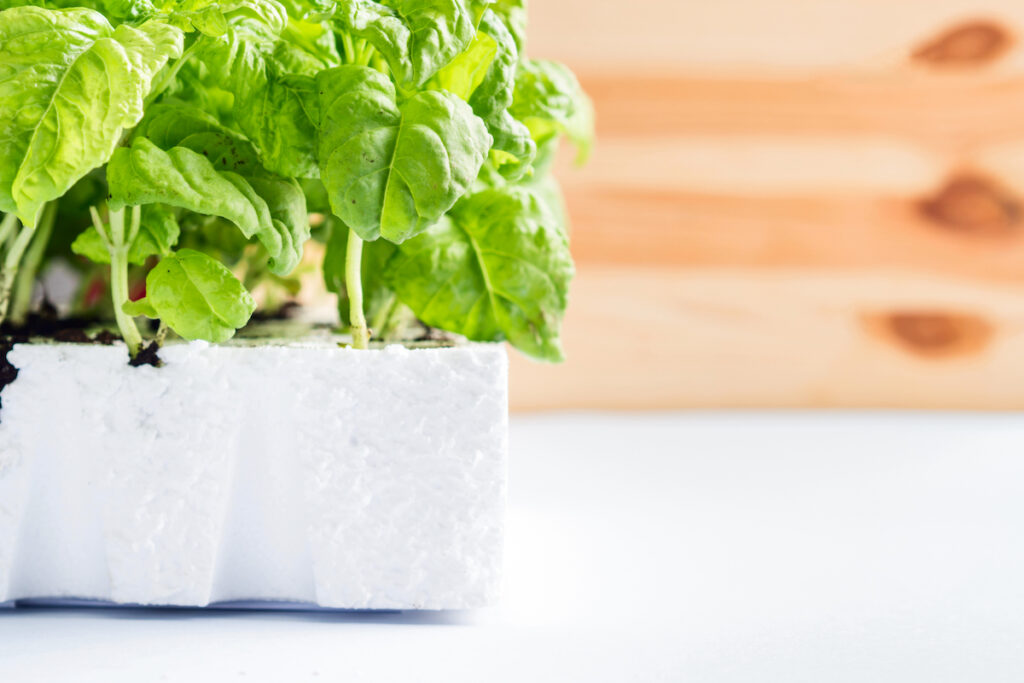
Basil responds best to moist soil and plenty of warm sunlight.
Keep the soil moist, but not too wet. For seeds, a spray bottle is a good way to water young plants in particular, as you don’t want to disturb the seedlings with the force of a water stream. It’s also important to be careful when watering your basil plants. Too much water will impact the growth, yet dry soil is also a no-no, and may cause wilting (yes, watering basil can be a bit finicky).
When your plants grow bigger, you can water more traditionally. Twice a week is usually sufficient, and you need to water enough that the water gets down to the roots, which the basil plants use to “drink.” The trick here is to make sure the roots don’t sit in a pool of standing water, as this can lead to root rot, mold growth and other diseases for your plants.
As you are probably growing your basil for it’s lush and nutritious leaves, you don’t want flower stalks to grow (unless you want to harvest seeds from your plant). When little white or purple flowers begin to form, or if your basil starts getting too tall, you can begin pinch leaves with your fingers and prune the basil flowers away. This process seems destructive, but it actually encourages your basil plant to grow bushier with more leaves, rather than taller, and extends the plant life. It also stops your plant wasting its growing energy on the flowers and forces the plant to concentrate on leaf production, which is what you want!
Propagating Basil Indoors
If you already have healthy, foliage-producing basil in your garden, or have a lovely friend or neighbor who is willing to share, you can propagate your basil from cuttings of their plants, and can do it all indoors.
This process can be a bit tricky, but if you manage it, you will have thick mature plants in much less time, at no cost!
You’ll need a pair of sharp scissors, multiple cups of water, and soil for this process.
- Starting with the healthy, mature plant, look for the point where a leaf and stem meet, that has around a 4-5 inch long stem. Cut the plant here. If there are multiple leaf nodes, use the lowest.
- Collect as many cuttings you’d like (opt for more, rather than less). You need to remove all the leaves from the bottom 2 inches of the cutting. This will give you a nice long stem to go in the water, any leaves that sit below the water line will go rotten and moldy.
- Place your 2 or 3 cuttings into each cup of dechlorinated water, and put them in an area where they can get plenty of hours of sunlight. On these first days it’s important to exchange the water for fresh each day too.
- Monitor and watch your cuttings as they start to develop and grow roots. This might take a week or more. You need to allow time for the roots to grow to a couple of inches long (maybe another week or two)
- Once they you have longer roots on your basil plants, you can transfer them into starter pots with potting soil.
Harvesting Basil
When you need to use it, it’s very simple to harvest basil.
Simply select the amount of leaves you want to use from the top of the plant and use sharp scissors to snip. Collecting from the top of the basil plant encourages new lateral growth, which will prevent the plant from getting too leggy. Growing bushier plants as opposed to taller plants with only a few leaves will give you a higher yield.
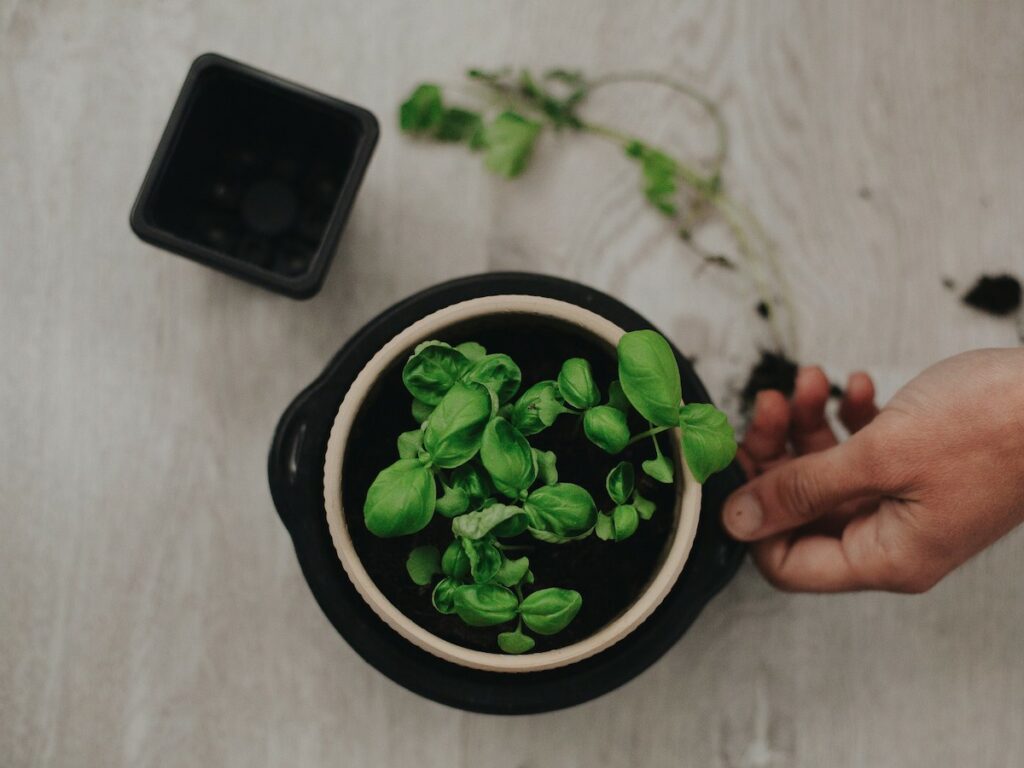
Storing Basil Leaves
The difference between growing basil indoors and outdoors is that you are not limited by the weather and climate of the growing season. For outdoor grown basil, you tend to have a bumper crop to harvest in the fall before the first frost arrives.
When indoor basil growing, this is less of an issue, and if using grow lights, you can continue harvesting basil year round. Only trimming it from the plant as and when you need it for optimum freshness!
If you do happen to collect too many leaves when harvesting basil, you can keep them inside an airtight container in your fridge. Adding a paper towel will also help to reduce the moisture and keep them fresher for longer.
You can also whizz up blanched basil leaves in a blender with olive oil and some salt. Pour this mixture into ice cube trays and freeze them for delicious pre-flavored additions for when you are cooking.
A Growing Shortcut…
If starting from seed sounds a little too much like hard work, you can always repot store bought container grown basil plants in your kitchen garden. This will give you an almost immediate crop, without any wait. (And we promise not to tell anyone!)
For repotting basil from a plant that’s fully grown, simply:
- Get the container you wish to plant your basil in ready by filling it with a nutrient rich soil with good drainage about 1/4 of the way.
- Remove the basil from the plastic container it was bought in and use your fingers to gently break up the root ball and mud caked around it.
- Carefully place each single plant into container with around 6 inches of space for growth to develop. You can then add more soil around it.
- Make sure the lowest leaves are level with the top of the pot and that the plant is not too far down inside the planter.
- Water your new basil plant and let it have some time adjust to its new home in a sunny place.
Final Thoughts on How to Grow Basil Indoors
For lovers of basil plants, you can now see how simple it is to begin growing basil indoors at home.
Find that sunny spot that has many hours a day of sunshine, and keep the soil moist and you’ll find your basil grows and thrives year round, without being restricted to the outdoor growing season.
For more articles and tips on growing basil, check out the rest of our blog.
